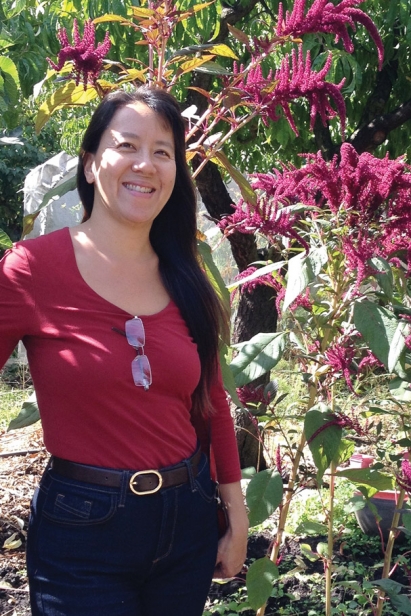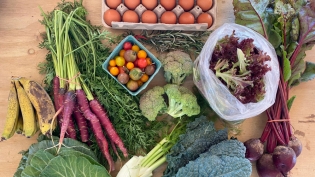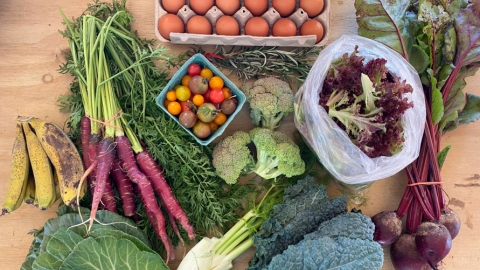Bounty from the Box: The Only Cookbook You’ll Need for CSAs (and More)
Before you sign up for that CSA – or renew your membership – we highly recommend Mi Ae Lipe’s Bounty from the Box: The CSA Farm Cookbook. From amaranth to zucchini, this 700-page encyclopedia tells you everything (and we mean everything) you need to know about fresh produce: how to select, prepare and store; recipes from celebrated chefs and food bloggers; stories about farmers; anecdotes and resources; and indexes so you can search for recipes by ingredient. You can find copies for sale from Bee Heaven Farm, at Aragon 101 or order it online.
CSAs are a terrific way to get fresh, weekly produce. But when you're looking at week number four of eggplant or bok choy, it can challenge even the most talented home cook. Bounty from the Box is a great resource for new ideas. Even better, Lipe includes tropical produce and takes into account South Florida’s growing season, which is generally the opposite of the rest of the U.S.
“That was one of the fascinating parts of doing this book – seeing the vast differences in the growing seasons and types of produce in both Floridian and Hawaiian CSAs and farmers markets,” she says. “I grew up in California, which grows many of its crops year-round, and then I moved to Wisconsin and Minnesota, where the distinct four-season climate very much dictates (and limits) what can be eaten fresh there. Folks in Florida are extraordinarily blessed to have such diversity and availability – it can be easy to take that abundance for granted. And your fruits are beyond incredible!”
In researching the book, Lipe says she learned how South Florida once provided the entire eastern U.S. with fresh fruits and vegetables in the winter months. “And it has been an eye-opener to see how farms in the tropical regions (Hawaii, too) have to adapt to the hot temperatures in the summer – the extreme heat and humidity and subsequent problems with funguses and blights is just too hard on both the plants and the farmers trying to control them.”
Lipe also says CSAs differ widely across the country. "My research assistants and I knew that there are a lot of CSA farms (it's estimated that around 7,000 exist throughout the United States), but we had absolutely no idea of their incredible diversity and enormous commitment to helping humanity in myriad ways," she says. "We found farms that help political refugees rebuild their lives, that grow food specifically for food pantries and cancer patients in hospitals, that use horticultural therapy to help rehabilitate adolescents in trouble with the law as part of their court orders, that provide oases in so-called urban food deserts, and that even use unused neighborhood backyards to help grow food for the local community, just to name a few. In a world where the media is constantly reporting bad news and tragedy, these stories really re-inspire faith in humanity."
Lipe’s book includes an extensive interview with Teena Borek of Teena’s Pride, whose CSA is one of the longest running programs. “Before I met Teena, I had no idea of the dilemmas that she and other South Florida farmers are facing due to cheaper produce coming in from Mexico. Her tenacity and grit through the past four decades, from taking on the farm after her young husband's death to weathering Hurricane Andrew, is amazing, but it's alarming that the farm that she has fought so hard to keep going all these years could still go under because of the dysfunctional economics of American vegetable farming.” All four of the biggest CSA farms featured in her book have had to diversify because they can't make it alone anymore from farming and selling wholesale to markets, she notes. “Now when I go into a local grocery store in the winter months, I'm much more aware – and irritated – that the only fresh produce they often carry is from Mexico, when it could be from Florida or another American family farm. We have a choice to vote with our wallets three times a day.”
Lipe says if there is one thing she wants most for readers to get out of Bounty from the Box, "It's the spirit of being open-minded―in the kitchen, in trying different food combinations and styles of eating, in learning more about their food, and in exploring where it comes from, why it matters, and what works best for them and their communities in terms of both practicality and health."
The recipes in Bounty from the Box come from many diverse sources, ranging from such celebrated professional chefs as Mollie Katzen and Yotam Ottolenghi to highly regarded food bloggers, home cooks, CSA farms, food associations, and other sources. "I felt that doing it this way would make it a much stronger, more interesting collection in terms of recipe diversity, and not restricted to just one type of cuisine or style of eating," she says.
To order, visit bountyfromthebox.com, where you can also browse and share recipes, and explore her enormous resource directory.











